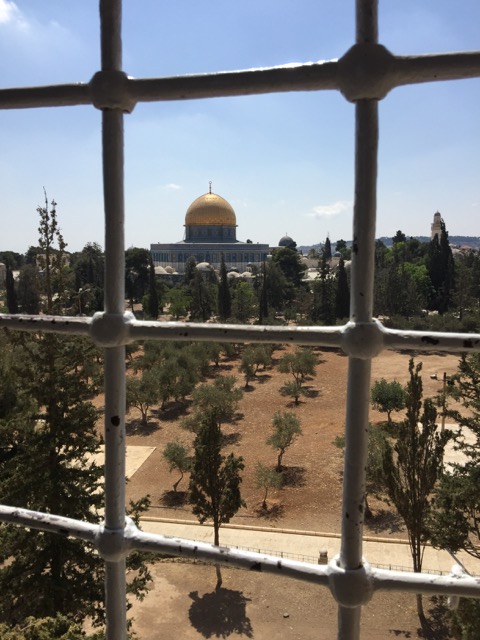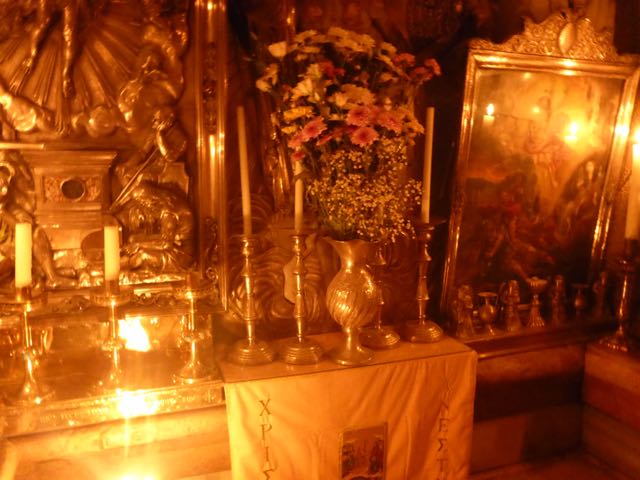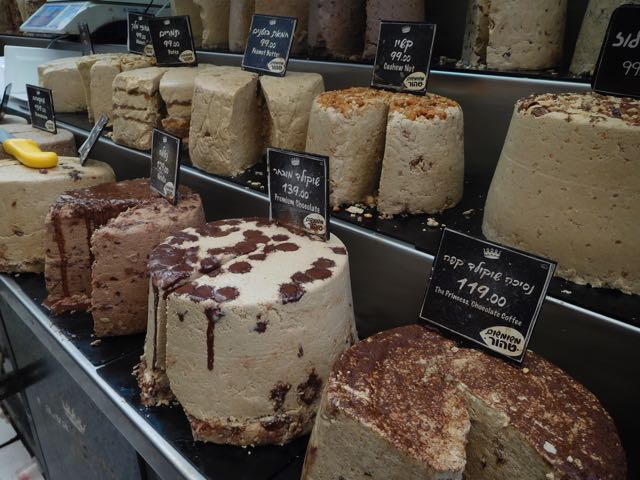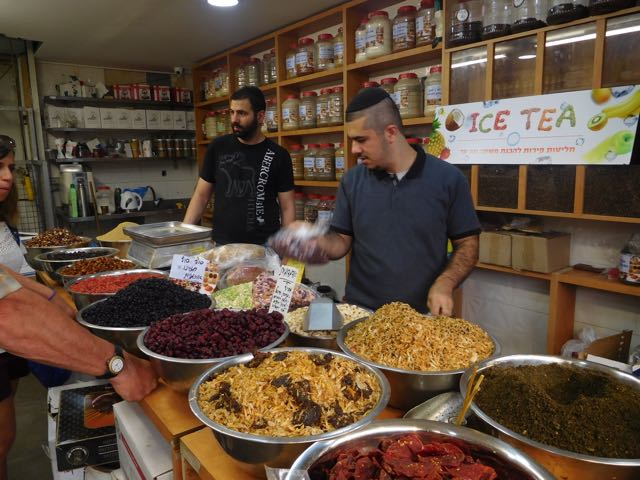 The Christians of Jerusalem are losing ground, although they still hold on to Jesus, Holy Mary, and some saints, since every inch of rock and soil in Jerusalem and its outskirts honors every footstep Christ must have made, and every miracle, healing and blessing he gave, even to recognizing the Sycamore Tree in Jericho up which Zacchaeus, a lonely chief tax collector who was too short to see him. Remembe Zacchaeus had climbed that tree to get a view of the Messiah. The Via Dolorosa (following the way of Jesus death walk), holds on a bit, although the streets of Old Time Jerusalem within the walls are so packed with wares, wanderers and weighty Westerners it’s hard to do a pilgrimage through the masses and keep your focus calm and cool while marking in the memory walk the agony of Christ’s experiences in what we call Holy Week.
The Christians of Jerusalem are losing ground, although they still hold on to Jesus, Holy Mary, and some saints, since every inch of rock and soil in Jerusalem and its outskirts honors every footstep Christ must have made, and every miracle, healing and blessing he gave, even to recognizing the Sycamore Tree in Jericho up which Zacchaeus, a lonely chief tax collector who was too short to see him. Remembe Zacchaeus had climbed that tree to get a view of the Messiah. The Via Dolorosa (following the way of Jesus death walk), holds on a bit, although the streets of Old Time Jerusalem within the walls are so packed with wares, wanderers and weighty Westerners it’s hard to do a pilgrimage through the masses and keep your focus calm and cool while marking in the memory walk the agony of Christ’s experiences in what we call Holy Week.
Jerusalem the golden is a place to experience the Orthodox churches, which seems to have in their care many of the important sites of Jesus’ life. Their celebrations are ornate and their priests stand out in their black attire. On the one hand, Jerusalem is a place all Christians who really believe need to visit, sort of like the Muslims with the Hajj. On the other, it is not as simple and spiritual as it used to be because there is so much struggling to get in and out and to figure what one can and cannot do or see on any given day or hour, and traffic is atrocious. True, there has been a horrid drop in tourism in all of the Middle East. As one guide said, he used to work 200 days a year. He now works 80. And this decline hurts everybody in the business even though the perimeters of every holy place, every hotel, every gathering place are secured by military and police and one passes through many points of inspection all over the Mid-East and Europe now.
Ultra-Orthodox, basic Orthodox and non-Orthodox Jews are everywhere: many are friendly and laughing merchants who can make your day, many weeping and nodding rabbis and school girls in prayer at the amazing Wailing Wall, and most having their own separate patches of freedom on the West Bank with walls and wire prison fences to make sure the wrong people don’t get in. The Ultra Orthodox, the ones where men wear black hats, black suits with long jackets, and have the long uncut curls as sideburns, don’t smile nor greet, living by so many rules and restrictions that they don’t work, play or do much but pray and have children for God, which their faith sponsors. Yet, probably the most jovial time I had in Israel was visiting the Jewish market Shouk Mahane Yehuda where venders wearing their Yarmulke or skull caps (believe it: now there are Yarmulke’s in colors with logo of favored soccer teams) gave taste samples of incredible herbs, spices, dried fruits, halvas (every kind of flavor possible) and Tahini (sesame butter). We went back two days in a row and even ate dinner at a precious open air restaurant Manou ba Shouk run by a French woman, sitting at a table right in the middle of all the market bustle. One quickly learns to love hummus, baba ganoush, falafel, tabouli, fatush, labana (yoghurt cheese) and many vegie “salads” which one can pile on fresh pita bread, even at breakfast. Big are eggplant, tomato, fried cauliflower, parsley and mint. Pomegranates and figs and dates are in full flower now, so we were continually offered a little cup of fresh squeezed pomegranate juice.
The Muslims increasingly dominate the space in Jerusalem, having cut off all access to the Dome of the Rock (which holds the giant boulder off of which Mohammed was said to ascend to heaven) to anyone other than Muslims, so I felt blessed that I had been allowed access in 1999 when I was in the city. The Muslim presence was especially evident during their own holy week called Eid Al Adha (Festival of Sacrifice), when families retire from work for five days to celebrate and visit with each other, sacrificing sheep or goat for a feast, all in honor of Ibrahim (Abraham) and Ishmael, from which they draw their faith and blood. It’s a time when streets are almost empty, until the 4th day when merchants reopen their booths in the Old City and egregious traffic restores. Of course in Saudi Arabia the Hajj was also under way, the once a year obligatory trek to Mecca for all men. And present everywhere are the tall thin towers of many mosques called minarets, in fact, right off the balcony of my room at the American Colony Hotel was one from which the Muslim call to prayer burst fourth five times a day: 4:30 a.m., 12:40 p.m. 3:30 p.m. 7 p.m. and 8:30 p.m. It is heard throughout the city no matter what faith you are, as the cantor sings or shouts out: “God is great, God is great. There is no God but God. I witness that Mohammed is his prophet. Let us work, let us pray. God is great, God is great.” It could be annoying but for me, it was a reminder to do my own prayer and thanksgiving to the one great God, and his son Jesus Our Savior, and that was something good.
My minutes in the Holy Land have been a deja vu pilgrimage and one that cracked my soul because things aren’t like they used to be. Religions are knuckle to knuckle in their daily movements, and one group doesn’t talk too kindly about the other, but I admire their persistence and bravery and the young Muslim women and men are gorgeous whether covered up or not. Covering up has become a curious issue in the states as we read things into its affect without really knowing. It doesn’t seem to be an issue here in the Holy Land of us all. In fact, the women are creative and colorful in their combinations of scarves and coverings and shoes (the finest), and even those who cover themselves in black (with face exposed), or some brilliant sapphire blue, or red or yellow, look fashionable and I could not see much difference from the many Christian nuns who also wander through the streets covered in long dresses and hats and head scarves that only expose the face. It’s the same effect. The nuns’ colors are gray, black white and touches of blue, depending on the order.
It’s that kind of world in Jerusalem, in Israel. And the cities are like piles of expanding blocks, oatmeal colored against the same color rock and dust. It’s that persistent color that floods the desert and gives a basis, a monotony, a security to those who worship and revel in their faith.






